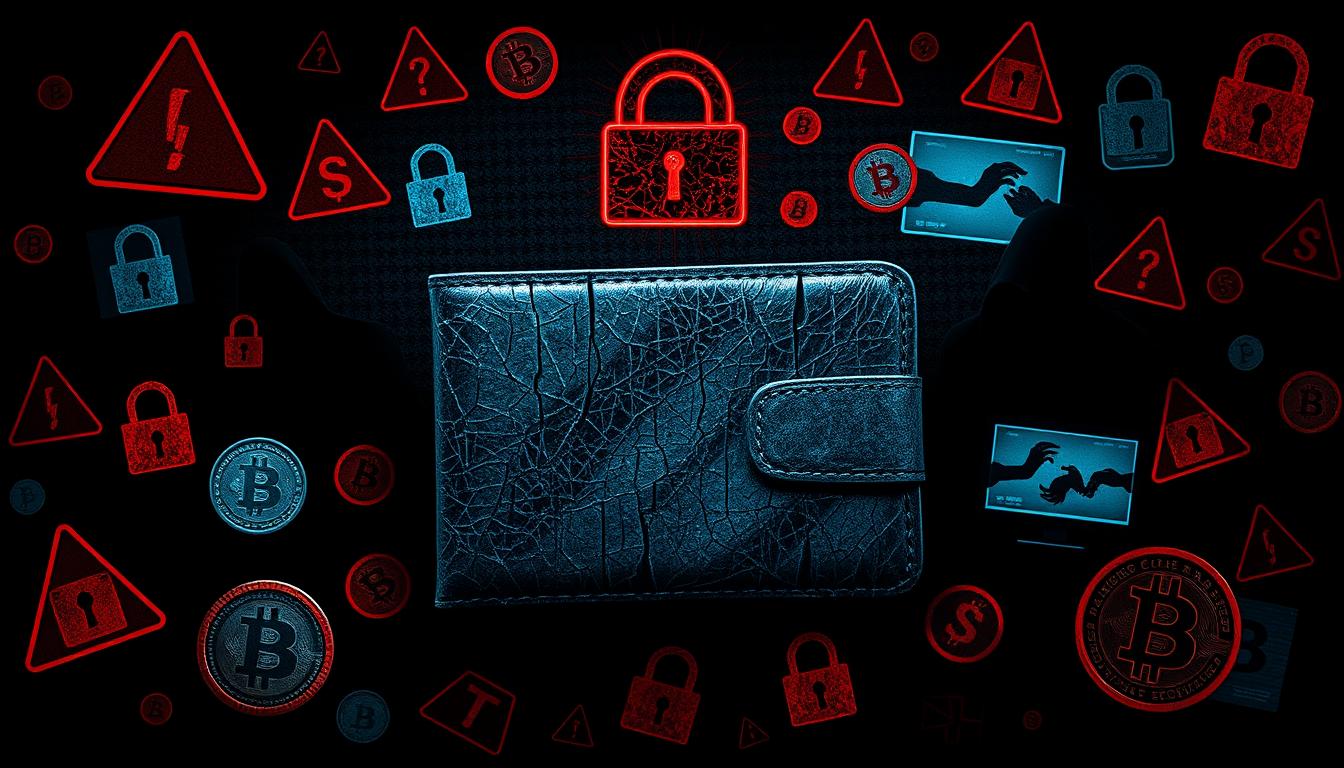In 2022, cryptocurrency hacks went up by 15%, with losses hitting $3.8 billion1. This worrying increase shows that crypto wallets are more at risk than ever. It’s key for people who love crypto to keep an eye out. Although digital currencies offer independence, many folks may unknowingly risk their wallets to hackers. If you put money into cryptocurrencies, being able to tell if your wallet is at risk is important to protect your investments.
But it’s not just expert hacker groups like North Korea’s Lazarus to look out for. Kaspersky found more than 85,000 scam emails aiming at both hot and cold crypto wallets in spring 2025 alone1. With phishing on the rise, knowing how to spot risks to your cryptocurrency wallet is crucial. Staying alert and using good security steps can help keep your money safe from threats.
Key Takeaways
- Understanding the increase in cryptocurrency hacks is vital for asset security.
- Recognizing scam emails can protect both hot and cold wallets.
- Learning the signs of a compromised wallet helps in deterring cyber threats.
- Vigilance and proactive measures are key to securing your digital assets.
- Educate yourself on the common cryptocurrency wallet vulnerability indicators.
Introduction: Understanding Crypto Wallet Security
People interested in cryptocurrencies come from various backgrounds. Some know a lot about security, while others are just starting. But, one major concern for everyone is crypto wallet security. It’s important to know how to keep your digital money safe. Knowing about different types of wallets and their risks is the first step.
Crypto wallets fall into two main categories: Custodial and Non-Custodial. Custodial wallets are like Coinbase, BlockFi, and Gemini. Non-Custodial wallets include Fireblocks, DAOs, and Gnosis Safe2. Wallets are also split based on their internet connection. Coinbase Wallet, Metamask, and Phantom are Hot Wallets. Ledger and Trezor2 are examples of Cold Wallets.
There’s also something called Smart Contract Wallets. They use codes to manage funds, with Argent and Gnosis Safe being well-known ones2. For added security, they might use tech like MPC and Multi-Sig2. But, Multi-Sig could have issues with new types of digital money2.
Checking your wallet’s security often involves looking out for odd signs. A seed phrase, which is a long list of words, should be kept secret. Never share it online3. Storing seed phrases safely can be done with tools like Coinplate3.
Watch for surprise transactions, wallet reset alerts, and many failed logins3. Learning to defend your crypto wallet means always being careful and informed. By being aware of common risks, you can better protect your digital assets.
Strange Account Activities
Keeping an eye on your crypto wallet is crucial. Watch out for unexpected transactions. These could mean someone else has accessed your wallet. In 2019, about $2.8 billion was laundered using crypto by criminals. This shows the big danger of unauthorized transactions. Today, less than 1% of crypto transactions are illegal. This is much less than the 35% in 20124.
Unexpected Transactions
Seeing transactions you didn’t make is a serious warning. It often means hackers have gotten into your wallet. Due to rules from organizations like the FATF and the EU4, crypto companies must follow strict money-laundering laws or face big fines. Watching your account closely helps catch any unusual activity fast.
Login Attempts from Unknown IPs
Finding login attempts from places you don’t recognize is another red flag. Hackers may try to get into your account this way. Such actions should worry you and prompt quick steps. The British police seized about $250 million in crypto in a big crackdown, showing the importance of watching out for odd logins and transactions4. Always keep an eye on your wallet for any sign of suspicious logins or unknown IPs.
| Red Flag | Possible Action |
|---|---|
| Unexpected Transactions | Immediately contact your wallet provider and review all transaction history. |
| Login Attempts from Unknown IPs | Change your password and enable two-factor authentication (2FA). |
| Unfamiliar Devices | Revoke access to all devices and re-authenticate only trusted ones. |
Declining Account Balances
If your account balance goes down and you don’t know why, it could mean someone has hacked your crypto wallet. Taking steps early to protect your digital money is key. Checking your transactions often helps you find and stop any strange activities right away. In 2021, people lost between $1 billion and $14 billion to crypto scams. This shows how crucial it is to watch your account closely5.
Review All Transactions
Going through your crypto wallet transactions regularly is a smart move. This way, if someone does something they shouldn’t with your account, you can catch it fast and fix the problem. Despite a decrease from $39 billion in 2022 to $24 billion in 2025, illegal transactions are still a huge risk6. Paying close attention to what goes in and out of your account stops scammers in their tracks and keeps your money safe.
Monitor Balance Regularly
Keeping an eye on your wallet balance is another important step. It helps you stay updated on your money and notice any drops right away. As digital currencies become more popular, scams like fake wallet balances are on the rise. Tricksters might show fake high balances to trick people6. By checking your balance often and knowing what’s normal for your wallet, you’re less likely to be fooled by these tricks.
Unusual Wallet Behavior
Have you found your wallet crashing suddenly or not working right? This could warn that your crypto wallet might be hacked. Such problems could show someone broke into your wallet’s security. Often, this happens because of harmful software designed to weaken your wallet, making it easy for thieves to steal your assets and invade your privacy.
Choosing a secure wallet service like BYDFi helps protect you from these dangers. If you spot anything odd, don’t wait to act. Reaching out to the support team of your wallet provider is a smart first move. While not all issues mean you’ve been hacked, unexplained problems often hint at a security risk. Shockingly, some have lost big, like $14,000 at coobe.im and almost $200,000 at tnegcoin.com7.
Knowing the signs of a compromised crypto wallet is key. Unapproved transactions or a sudden low balance can mean trouble. Changes in how things look or functions acting up, like apps quitting by themselves, are warning signs too. Taking steps urgently, like updating your password and using two-factor authentication, is crucial for your wallet’s safety8.
Understanding these warning signs can prevent major losses. For example, a person lost $190,000 to a scam pretending to be Crypto.com at cryptocomwallettc.com. Another lost $200,000 thinking they had made big profits7.
Staying alert to unusual wallet behavior and putting in place safety measures, helps you keep your digital assets secure.
Unauthorized Device Access
Your crypto wallet faces a big risk from unauthorized device access. Hackers can find ways in through malware, scams, or direct attacks. To keep your digital money safe, it’s essential to be always on guard with strong security steps.
Check Login Devices
It’s key to check login devices often to fight unauthorized access. Make sure to review all devices that have entered your wallet. Unexpected transactions or wallet resets could mean someone else has gotten in9. Always stay alert. Avoid using unknown networks and watch out for anything odd to keep your crypto safe10.
Enable Two-Factor Authentication
Two-factor authentication (2FA) adds more security to your digital wallet. It uses a second check, like a text message code, to stop hackers. Quick reaction to a compromised seed phrase helps stop more unwanted access and protects your assets9. Putting in 2FA makes it harder for hackers to get into your account.
Alerts from Security Tools
Security tools play a crucial role in protecting cryptocurrency wallets. They constantly monitor wallet activity. They immediately alert users when they spot unexpected behavior. For example, unauthorized transactions could mean your seed phrase is compromised11. These alerts are key in stopping wallet drainers, which have stolen about $81 million from 134,000 people in a major case12.
To effectively respond to these alerts, be vigilant and act quickly. Keeping your device’s software up to date and knowing about new scams are vital steps11. Using a service like Wallet Rescue can also help get back assets from hacked wallets on big networks like Ethereum, BNB Chain, and Polygon12. Alerts act as an early warning, helping protect your digital money.
Here’s a table that breaks down key actions for stronger wallet security:
| Action | Description |
|---|---|
| Two-Factor Authentication (2FA) | Provides an extra layer of security, making it harder for unauthorized users to gain access to your wallet. |
| Regular Software Updates | Ensures the latest security patches are applied, protecting against known vulnerabilities. |
| Awareness of Scams | Staying informed about common scams and phishing attempts can help you avoid falling victim. |
| Utilizing Security Tools | Tools designed to monitor and alert you to unusual activities can help prevent losses. |
| Investing in Physical Backups | Backing up your seed phrases on physical devices like Coinplate to prevent digital theft11. |
Phishing Attacks
In the fast-moving world of cryptocurrency, phishing attacks are more common than ever. Scammers pretend to be trustworthy to steal your digital assets. You must stay alert and follow the best ways to keep your crypto wallet safe. Let’s look at how to spot fake links and make sure links are genuine to stay secure.
Identify Scam Links
Knowing how to spot fake links is key to protecting your crypto. Scammers craft convincing fake websites and emails. A top method to spot these is by examining the URL closely. Look out for small spelling mistakes, odd characters, or strange domains. You might see “coinbasee.com” instead of “coinbase.com,” or “c0inbase.com.”
Checking URLs carefully can help you avoid these traps. Many cryptocurrency users end up putting their security at risk by not doing this13. Just by double-checking links, you can greatly lower the chance of becoming a phishing attack victim.
Verify Authenticity Before Clicking
It’s essential to check if a link is authentic before clicking on it. This extra step is crucial for fighting against phishing. Confirm who sent the message and compare any unexpected emails with official sources. Say you get an email from Coinbase. Go directly to the official Coinbase website yourself to see if it’s true. Don’t just click on a link in the email.
The average loss per victim in 2025 was $28,00014. Being careful and questioning links can prevent major losses. With almost $2 billion lost to scams and hacks in 2025, extra caution is definitely needed14.
Your Wallet is Controlled by a Third Party
When you let a third party handle your cryptocurrency wallet, you face many risks. Service issues, mistakes, or worse, theft, can happen. This means you may not fully control your money.
The phrase “Not your keys, not your crypto” really matters. It means if you take care of your own wallet, it’s safer. From 2011 to 2019, hackers stole $2.71 billion from crypto services, and by 2022, losses hit $3.8 billion15.
Using a third-party wallet means you have to trust them a lot. Even the top companies can be attacked. For instance, scammers made over 7,900 fake blockchain wallets to steal cryptocurrency in May16.
Phishing is another big danger for your wallet. Criminals pretend to be famous companies to trick people. They often promise big money returns or set up fake online contests17. Making sure any message about your wallet is real is very important.
Choosing to manage your wallet by yourself doesn’t mean you’re less safe. Using devices like Ledger Nano S or Trezor helps keep your crypto secure offline15. Keeping your wallet to yourself is safer and more dependable for long-term cryptocurrency holding.
To see why handling your own wallet is better than someone else doing it, let’s compare:
| Factors | Third-Party Wallet Control | Self-Custody |
|---|---|---|
| Control over Funds | Limited | Full Control |
| Security | Dependent on provider | High (using hardware wallets) |
| Vulnerabilities | High | Reduced |
| Risk Factor | Significant | Lower |
Your Wallet is Regularly Connected to the Internet
Having your wallet online can be risky because hackers can get to it. Using devices that are never online keeps your wallet safe from hackers.
Use Air-Gapped Devices
Air-gapped devices stay offline, offering top-notch protection for your money. They shield you from internet threats. Cold wallets like TREZOR, KeepKey, and Ledger Nano X are built to stay offline. This makes them more secure than hot wallets like MetaMask and Coinbase Wallet, which are always connected to the internet18.
Disconnect from Internet When Not in Use
Turning off your wallet’s internet when you’re not using it is key. This action lowers the chance of facing cyber attacks19. Hot wallets stay online all the time and are at greater risk18. Keeping your wallet offline protects your digital money.
| Type of Wallet | Connectivity | Security Level |
|---|---|---|
| Hot Wallet (MetaMask, Coinbase Wallet) | Connected to the Internet | Lower |
| Cold Wallet (TREZOR, KeepKey) | Never Connected to the Internet | Higher |
Weak RNG Mechanisms for Seed Phrase Generation
A strong start for your crypto wallet’s security is key. This begins with how the seed phrase is created. The randomness from the Random Number Generator (RNG) is very important for seed phrase security. A weak RNG might create patterns that are too easy to guess. This makes your wallet an easy target for attacks. So, making sure your RNG is truly random is vital.
Ensure True Randomness
Today, many wallets are boosting their game to make seed phrases more random. For example, the Trezor T wallet makes its seed phrases away from online threats20. Similarly, Atomic Wallet secures the creation of seed phrases offline. This step blocks hackers from stealing your info through keyloggers21.
Consider Additional Layer of Randomness
By adding more randomness, you make your seed phrase even safer. Methods like coin flips or dice rolls bring extra unpredictability. This helps guard your wallet better. Using quirky things like lava lamps to add randomness is another cool option. These steps make sure your wallet’s security isn’t just based on ordinary RNG methods.
Choosing non-custodial wallets, such as Atomic Wallet, adds another safety layer21. These wallets let you keep full control over your money. Since you manage your seed phrases and keys, you avoid risks from compromised systems.
| Wallet | Key Security Features |
|---|---|
| Trezor T | Generates seed phrases offline, frequent security audits20 |
| Atomic Wallet | Offline seed phrase generation, local storage of private keys21 |
| Jaxx | Backup phrase, 4-digit pin setup20 |
Using Cloud Drive for Backups
Backing up your crypto wallet is key. But, using cloud drives for this can up your risk due to potential hacks or service breaks. ZenGo, the pioneer in cloud backup for wallet restoration, highlights cloud risks for wallets dependent on a single secret like a private key22. Similarly, Metamask warns users about the dangers of backing up private keys in the cloud22.
A huge 80% of dangers with online private key storage can be dodged by keeping them offline23. It’s wise to have more than one backup for private keys, in different places, to boost safety23. Experts suggest writing down seeds on paper or etching them on steel for ultimate safety against online threats23. Cypherock X1, a hardware wallet, lets users safely store up to four seed phrases or wallets24.
Storing your seed phrase on metal plates or with engravings shields against both physical and online dangers. Spreading out storage ways and having several wallets can majorly lower the risk of total loss if one wallet gets hacked24.
In short, cloud drive backups are handy but come with risks. Multi-signature wallets and MPC wallets like ZenGo up security since they don’t lean on just one key for entry22. Given that many wallets and apps, like Coinbase’s, automatically back up to iCloud, understanding how to protect your crypto assets is essential22.
Conclusion
The security of your cryptocurrency wallet depends on how careful and proactive you are. Spotting signs of trouble, like unexpected transactions or security tool warnings, is key. For example, the FBI said cybercriminals stole over US$1.3 billion in crypto in early 202225. By knowing the risks, you can better guard your wallet.
Using good habits is crucial too, such as keeping your wallet offline and making your seed phrase extra random. The top rule: never share your seed phrase26. It’s crucial for keeping your crypto safe. For a stronger defense, think about using Coinplate for physical seed phrase backup, which can prevent loss by up to 70%26.
Staying informed and careful helps protect your digital money against many cyber threats. Always watch for anything odd, and act fast if something seems wrong. This knowledge lets you keep your crypto secure against cyber attacks. Let’s ensure our investments in the digital currency world are safe.









